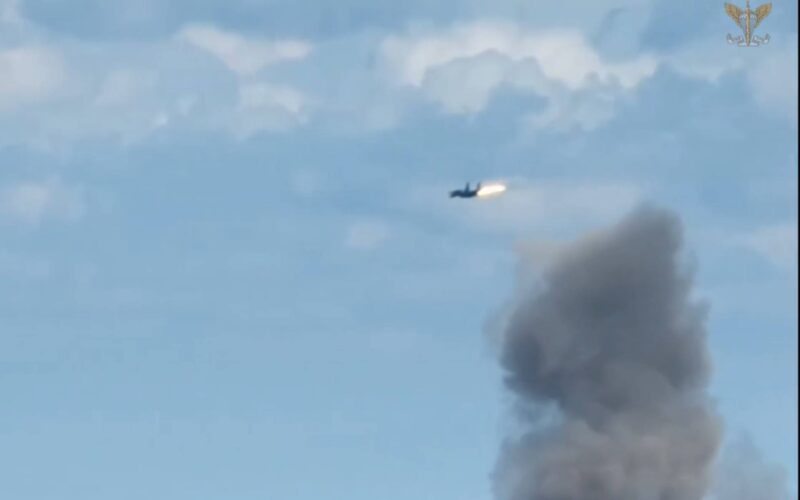Today marks one year since Russia launched its full-scale invasion of Ukraine on February 24, 2022.
At no other point in history has a war of such scale been waged under the watchful eye of so many recording devices. Footage from civilian phones, observation cameras and even the screens of advanced guided weapons immediately flooded the internet, likely making the invasion one of the most well-documented.
But what have been some of the most interesting episodes captured on video during the past year? And what can they tell us about the ongoing war?
In this article, AeroTime revisits previous articles and explains what the footage tells us about the ongoing conflict in Ukraine.
Civilians with phone in hand
While Antonov Airlines and its flagship An-225 Mriya, the largest aircraft in the world, were among the best-known Ukrainian brands across the globe, its main base Hostomel Airport was decidedly less famous.
But that changed on February 24, 2023, when the airport was subjected to intense Russian bombardment and a paratrooper attack, as the country’s airborne forces attempted to capture it and establish a bridgehead for more troops to be flown in.
Hundreds of videos of Russian helicopters attacking the airport soon began to surface online, with much of the footage filmed by bystanders to the unfolding conflict.
The Battle of Kyiv continued for more than a month and ended in the eventual retreat of Russian forces. It also resulted in horrifying civilian losses and severe damage to infrastructure, with towns north of Kyiv devastated by intense combat.
Hostomel Airport and the fleet of Antonov airlines were some of the most notable material casualties of the battle. As footage of the aftermath showed, the airport was ravaged, and many unique aircraft lay in ruins.
Heroic moments
By April 2022 Russia had refocused its attack on the East of Ukraine, which led to the stabilization of the frontlines. There was also a sharp drop in the amount of combat footage filmed by civilians because non-combatants were less likely to find themselves in the middle of a battle. At the same time, militaries on both sides became stricter with enforcing operational security, as even one soldier with a mobile phone could reveal the location of an entire unit.
Hand-held footage became scarcer. However, it was still being published online, likely only after thorough screening by the poster’s superiors, meaning that we were privy to some of the most spectacular footage of aircraft being shot down over Ukraine.
Some of this footage was captured by soldiers who operated the Stugna, a Ukrainian-made laser-guided anti-tank missile system, used with spectacular effect on anything from Russian tanks to helicopters.
Other footage showed Ukrainians attempting to stop Russian bombardment with whatever means possible, including man-portable air defense systems (MANPADS) and air-to-air missiles launched from fighter jets.
Drones everywhere
One of the most notable features of the war has been the wide use of drones. On the one hand, drones have become an integral asset for any military during the past two decades. On the other hand, remotely controlled aircraft provide the perfect opportunity to capture video footage for later dissemination, which is why some of the most spectacular moments of the entire war were filmed by drones.
In the early days of the war a fleet of Turkish-made Bayraktar TB2 drones were instrumental in Ukraine’s effort to blunt the Russian attack, performing reconnaissance and bombing runs with near impunity while Russia struggled to establish its air defense network.
However, the role of large drones, such as the TB2, became far less important after the establishment of robust ground-based air defense (GBAD) networks in April-May 2022. Only significant frontline shifts, such as Ukraine’s advances near Kherson and Kharkiv, disrupted those networks enough to renew the use of Bayraktars in a strike role.
With the absence of Bayraktars, another source of video footage became widespread. This time, filmed from smaller drones, which were wielded in huge quantities by both the Ukrainian and Russian forces. Such drones became an indispensable part of the warfare that continues to unfold to this day, performing a myriad of roles from observation and surveillance of the frontlines to artillery spotting and the assessment of damage.
A new kind of warfare
Not only were commercial drones utilized in passive observation role, but they also began to play an active part in the conflict.
Soldiers have been attaching explosives on small quadcopters to be dropped on – or plunged into – an enemy in past conflicts too. But only in Ukraine did this trend go beyond the occasional use and become the focus of entire units, with bomb-equipped drones being the only way to intrude beyond well-protected frontlines and harass the rear of enemy deployments.
One of the most spectacular cases of such attacks was a bombing run conducted by a Ukrainian drone in August 2022, when a Russian electronic warfare system, specifically designed to target small drones, was destroyed.
The proliferation of commercial quadcopters made their “meetings” above the frontline an inevitability. And so, the dogfights between remotely controlled drones began, with both sides attempting to strike down the enemy’s aircraft without damaging their own.
When AeroTime covered the first instance in October 2022, it seemed like a novel idea. However, since then, scores of similar video footage emerged, demonstrating a completely new kind of aerial warfare.

